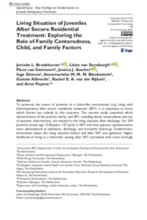Abstract
To promote the return of juveniles to a home-like environment (e.g. living with (foster)parents) after secure residential treatment (SRT), it is important to know which factors are related to this outcome. The current study, based in the Netherlands, examined which characteristics of the juvenile, family, and SRT, including family centeredness and use of systemic interventions, are related to the living situation after discharge. For 259 juveniles (mean age 15.82 years, 127 girls) in SRT and their parents, questionnaires were administered at admission, discharge, and 6-months follow-up. Furthermore, information about the living situation before and after SRT was gathered. Higher likelihood of living in a home-like setting after SRT correlated with more furlough moments with parents, receiving a systemic intervention, and a shorter duration of the SRT. Systemic interventions during SRT and spending furlough moments with parents may have a positive impact on returning to a home-like situation after SRT for juveniles.

